Mars Polar Lander Timeline

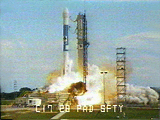 Jan 3, 1999: Lander Launched.
The lander's first scheduled launch opportunity was at 3:21 PM EST, Jan 3, 1999.
Subsequent launch opportunities would have occurred at approximately 3 pm each
day of the primary launch window.
The Delta rocket's four solid rocket motors separated from the vehicle
at T+66 seconds and fell into the Atlantic Ocean.
The Delta's first stage separated at T+4 minutes, 32 seconds. The Delta's
second stage separated at T+35 minutes.
Jan 3, 1999: Lander Launched.
The lander's first scheduled launch opportunity was at 3:21 PM EST, Jan 3, 1999.
Subsequent launch opportunities would have occurred at approximately 3 pm each
day of the primary launch window.
The Delta rocket's four solid rocket motors separated from the vehicle
at T+66 seconds and fell into the Atlantic Ocean.
The Delta's first stage separated at T+4 minutes, 32 seconds. The Delta's
second stage separated at T+35 minutes.
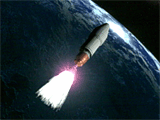 Jan 3, 1999: Lander Leaves Earth.
At T+36 minutes, the lander's third stage fired for a 88 seconds, providing the lander with enough velocity to leave Earth orbit and set it
on a course to rendezvous with Mars. At T+47 minutes after
liftoff, the lander separated from the third stage. At approximately
T+53 minutes, the lander deployed its solar panels and radioed back to Earth that all systems were go and it was safely on its way to Mars.
Jan 3, 1999: Lander Leaves Earth.
At T+36 minutes, the lander's third stage fired for a 88 seconds, providing the lander with enough velocity to leave Earth orbit and set it
on a course to rendezvous with Mars. At T+47 minutes after
liftoff, the lander separated from the third stage. At approximately
T+53 minutes, the lander deployed its solar panels and radioed back to Earth that all systems were go and it was safely on its way to Mars.
 Jan 3, 1999 - Dec 3, 1999: Lander Interplanetary Cruise.
The lander is cruising to Mars powered by a cruise stage that provides
maneuvering capability and solar power. During the 11-month cruise,
a series of trajectory correction maneuvers will be performed to steer
the lander towards its target entry point at the top of the Martian atmosphere.
Jan 3, 1999 - Dec 3, 1999: Lander Interplanetary Cruise.
The lander is cruising to Mars powered by a cruise stage that provides
maneuvering capability and solar power. During the 11-month cruise,
a series of trajectory correction maneuvers will be performed to steer
the lander towards its target entry point at the top of the Martian atmosphere.
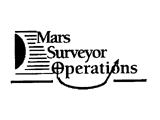 Feb 3, 1999: New Management.
Thirty days after launch, JPL's Mars Surveyor Operations Project (MSOP)
formally took over the operation of the Mars Polar Lander. MSOP has responsibiltiy for operating all the spacecraft in the Mars Surveyor Program,
which includes the Mars Global Surveyor (MGS) orbiter, the Mars Climate Orbiter (MCO) and the Mars Polar Lander (MPL). Richard A. Cook is the MSOP project manager. Sam Thurman is the Mars Polar Lander Mission Director.
Feb 3, 1999: New Management.
Thirty days after launch, JPL's Mars Surveyor Operations Project (MSOP)
formally took over the operation of the Mars Polar Lander. MSOP has responsibiltiy for operating all the spacecraft in the Mars Surveyor Program,
which includes the Mars Global Surveyor (MGS) orbiter, the Mars Climate Orbiter (MCO) and the Mars Polar Lander (MPL). Richard A. Cook is the MSOP project manager. Sam Thurman is the Mars Polar Lander Mission Director.
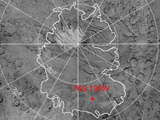 Aug 24, 1999: Final Landing Site Selected.
The final landing site for the Mars polar lander was selected on August 24, 1999. New photographic and topographic observations of the
landing site region had just been acquired by the Mars Global
Surveyor Orbiter. These data augmented the existing data
acquired by the Mariner-9 orbiter in 1971,
the Viking orbiters in 1976-1982, and the Mars Global Surveyor orbiter
in 1998. The final decision regarding the MPL landing site was
made by NASA headquarters based on advice from MSOP and independent
reviews by the scientific and engineering communities.
Aug 24, 1999: Final Landing Site Selected.
The final landing site for the Mars polar lander was selected on August 24, 1999. New photographic and topographic observations of the
landing site region had just been acquired by the Mars Global
Surveyor Orbiter. These data augmented the existing data
acquired by the Mariner-9 orbiter in 1971,
the Viking orbiters in 1976-1982, and the Mars Global Surveyor orbiter
in 1998. The final decision regarding the MPL landing site was
made by NASA headquarters based on advice from MSOP and independent
reviews by the scientific and engineering communities.
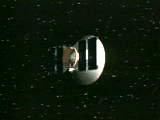 December 2, 1999: Final Trajectory Correction.
Less than three days before landing, one, or possibly two final trajectory correction
maneuvers will be performed to steer the lander as close as possible to
its final landing site. The lander's error ellipse is expected to
be 120 km long by 10 km wide.
December 2, 1999: Final Trajectory Correction.
Less than three days before landing, one, or possibly two final trajectory correction
maneuvers will be performed to steer the lander as close as possible to
its final landing site. The lander's error ellipse is expected to
be 120 km long by 10 km wide.
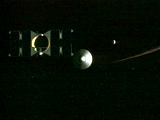 Dec 3, 1999: Cruise Stage Jettisoned.
Ten minutes before landing, the lander's cruise stage will be jettisoned and
the lander's heat shield will be oriented for atmospheric entry.
For a successful landing,
the lander must intercept the atmosphere within 1 degree
of its nominal entry angle. Too shallow an entry angle will cause
the lander to skip off the atmosphere back into space. Too steep an entry
angle will cause the lander to burn up in the atmosphere.
Dec 3, 1999: Cruise Stage Jettisoned.
Ten minutes before landing, the lander's cruise stage will be jettisoned and
the lander's heat shield will be oriented for atmospheric entry.
For a successful landing,
the lander must intercept the atmosphere within 1 degree
of its nominal entry angle. Too shallow an entry angle will cause
the lander to skip off the atmosphere back into space. Too steep an entry
angle will cause the lander to burn up in the atmosphere.
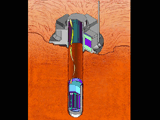 Dec 3, 1999 Mars Microprobes Released.
Prior to entry, two 3.5 kg penetrators provided by JPL's New Millenium Deep
Space Project
will be released. The probes will enter the atmosphere and impact the
Martian surface approximately 100 km uprange of the lander. Each probe
will consist of a forebody which will penetrate up to meter into the Martian
soil, and an aftbody which will remain on the surface. A water experiment will collect
a small quantity of soil and heat it to release water. The aftbody
contains electronics and an antenna to be used for one-way communication
whith the Mars Global Surveyor Orbiter. The probes will be powered by
non-rechargable batteries and are expected to survive for two days.
Sarah Gavit of JPL is the New Millenium Microprobe program manager
and Suzanne Smrekar of JPL is the New Millenium project scientist.
Dec 3, 1999 Mars Microprobes Released.
Prior to entry, two 3.5 kg penetrators provided by JPL's New Millenium Deep
Space Project
will be released. The probes will enter the atmosphere and impact the
Martian surface approximately 100 km uprange of the lander. Each probe
will consist of a forebody which will penetrate up to meter into the Martian
soil, and an aftbody which will remain on the surface. A water experiment will collect
a small quantity of soil and heat it to release water. The aftbody
contains electronics and an antenna to be used for one-way communication
whith the Mars Global Surveyor Orbiter. The probes will be powered by
non-rechargable batteries and are expected to survive for two days.
Sarah Gavit of JPL is the New Millenium Microprobe program manager
and Suzanne Smrekar of JPL is the New Millenium project scientist.
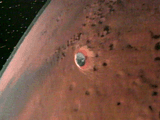 Dec 3, 1999: Atmospheric Entry. The lander will begin its encouter with
the Martian atmosphere
approximately 4 minutes and 33 seconds before landing. During this
period, the lander will use the friction produced by the Martian
atmosphere to decellerate rapidly from its initial velocity of 6.8 km per
second. The temperature of the lander's heat shield will increase to 1650 °C
and it will experience peak G forces of 12 times Earth's gravity.
Dec 3, 1999: Atmospheric Entry. The lander will begin its encouter with
the Martian atmosphere
approximately 4 minutes and 33 seconds before landing. During this
period, the lander will use the friction produced by the Martian
atmosphere to decellerate rapidly from its initial velocity of 6.8 km per
second. The temperature of the lander's heat shield will increase to 1650 °C
and it will experience peak G forces of 12 times Earth's gravity.
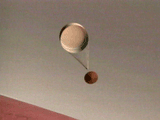 Dec 3, 1999: Parachute Opens. Approximately two minutes before landing,
the lander's parachute will be deployed. By this time, the lander
will be traveling at a speed of 493 meters per second and will be
7.3 km above the Martian surface.
Dec 3, 1999: Parachute Opens. Approximately two minutes before landing,
the lander's parachute will be deployed. By this time, the lander
will be traveling at a speed of 493 meters per second and will be
7.3 km above the Martian surface.
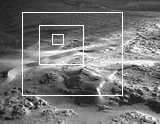 Dec 3, 1999: MARDI Acquires Descent Images. Ten seconds after the parachute opens, the
Mars Descent Imager (MARDI) will begin taking images. The first image
will be acquired 0.3 seconds before the heat-sheild is jettisoned. MARDI
will take approximately 10 images of the Martian surface
at increasing resolution as the lander descends. The fields of view
of the MARDI images will decrease from 8 km across to 9 meters across just before landing.
Dec 3, 1999: MARDI Acquires Descent Images. Ten seconds after the parachute opens, the
Mars Descent Imager (MARDI) will begin taking images. The first image
will be acquired 0.3 seconds before the heat-sheild is jettisoned. MARDI
will take approximately 10 images of the Martian surface
at increasing resolution as the lander descends. The fields of view
of the MARDI images will decrease from 8 km across to 9 meters across just before landing.
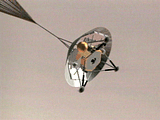 Dec 3, 1999: Lander Legs Deployed. Approximately 100 seconds before landing,
the lander legs will be extended and a landing radar will be activated
to determine the distance to the Martian surface.
Dec 3, 1999: Lander Legs Deployed. Approximately 100 seconds before landing,
the lander legs will be extended and a landing radar will be activated
to determine the distance to the Martian surface.
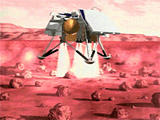 Dec 3, 1999: Touchdown. Approximately 1.4 km above the surface, the
lander's parachute and backshell will be separated and the lander will
use a set of thrusters to perform a 35-second controlled descent to the Martian
surface. Inertial gyros and accellerometers will be used to orient the
lander during its final descent. The lander will land facing the
best direction for its solar panels to generate power once it lands.
The lander will not be in radio contact with the Earth at any point
during the entry, descent and landing phase of the mission.
Dec 3, 1999: Touchdown. Approximately 1.4 km above the surface, the
lander's parachute and backshell will be separated and the lander will
use a set of thrusters to perform a 35-second controlled descent to the Martian
surface. Inertial gyros and accellerometers will be used to orient the
lander during its final descent. The lander will land facing the
best direction for its solar panels to generate power once it lands.
The lander will not be in radio contact with the Earth at any point
during the entry, descent and landing phase of the mission.
Next >>
|

